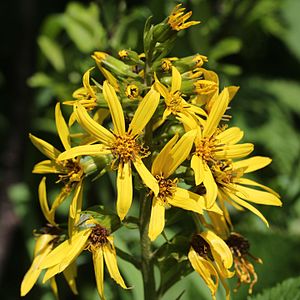Ligularia fischeri
| Ligularia fischeri | |
|---|---|

| |
| Scientific classification | |
| Kingdom: | Plantae |
| Clade: | Tracheophytes |
| Clade: | Angiosperms |
| Clade: | Eudicots |
| Clade: | Asterids |
| Order: | Asterales |
| Family: | Asteraceae |
| Genus: | Ligularia |
| Species: | L. fischeri
|
| Binomial name | |
| Ligularia fischeri | |
| Synonyms | |
|
Synonyms
| |
Ligularia fischeri, known as gomchwi,[2] Fischer's ragwort,[2] or Fischer's leopard plant,[3] is a species in the genus Ligularia (family Asteraceae). It is native to east Asia.[3]
Description
Ligularia fischeri is a clump-forming herbaceous perennial and can grow up to 2 m (6 ft 7 in) tall. It has coarsely toothed, kidney-shaped light green basal leaves, up to 40 cm (16 in) across, on long stalks, the stem leaves smaller and on shorter stalks. The in midsummer, it has racemes of up to 75 cm (30 in) long of yellow flowerheads, 5 cm (2 in) across. Later after it has bloomed, it produces a seed capsule, with seeds with downy hairs which are tinged brown or purple.[3]
Culinary use
Korea
In Korean cuisine, the leaves of gomchwi along with other chwinamul varieties are often used as the main ingredient of herbal side dishes called namul. Gomchwi can be eaten pickled as jangajji or kimchi, and eaten fresh as a ssam (wrap) vegetable.
Gomchwi-jangajji (pickled gomchwi)
References
- ^ "Ligularia fischeri (Ledeb.) Turcz". The Plant List. Royal Botanic Gardens, Kew. Retrieved 6 December 2016.
- ^ a b English Names for Korean Native Plants (PDF). Pocheon: Korea National Arboretum. 2015. p. 517. ISBN 978-89-97450-98-5. Archived from the original (PDF) on 25 May 2017. Retrieved 6 December 2016 – via Korea Forest Service.
- ^ a b c "Ligularia fischeri". Royal Horticultural Society. Retrieved 9 May 2021.
External links
![]() Media related to Ligularia fischeri at Wikimedia Commons
Media related to Ligularia fischeri at Wikimedia Commons
![]() Data related to Ligularia fischeri at WikispeciesError: "Q5759556" is not a valid Wikidata entity ID.
Data related to Ligularia fischeri at WikispeciesError: "Q5759556" is not a valid Wikidata entity ID.
- Articles with short description
- Articles with 'species' microformats
- Commons category link is defined as the pagename
- Taxonbars desynced from Wikidata
- Taxonbar pages requiring a Wikidata item
- Taxonbars with invalid from parameters
- Taxonbars without secondary Wikidata taxon IDs
- Korean vegetables
- Namul
- Ligularia
- Taxa named by Nikolai Turczaninow
- All stub articles
- Senecioneae stubs
